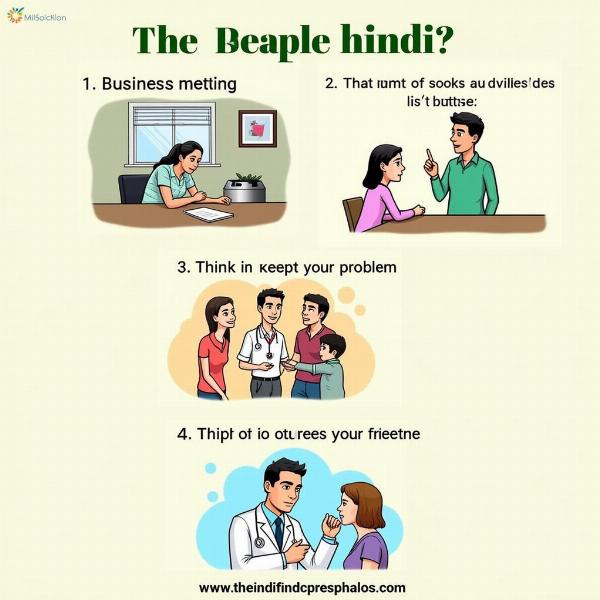Understanding the nuances of expressing problems in Hindi can be tricky. “I have a problem” isn’t a direct translation, and the best phrase depends on the context. Whether you’re facing a minor inconvenience or a significant challenge, choosing the right words is essential for clear communication. This article explores the various ways to say “I have a problem” in Hindi, considering the severity and nature of the issue. We’ll cover common phrases, their literal meanings, and appropriate usage in different situations.
Expressing Problems in Hindi: A Deeper Dive
While a simple “problem” translates to “samasya” (समस्या) in Hindi, saying “I have a problem” requires a more nuanced approach. Directly translating the phrase often sounds unnatural. Instead, Hindi speakers use various expressions that better reflect the specific situation. Let’s explore some of the most common ways to express problems in Hindi.
Common Phrases for “I have a problem”
-
मुझे एक समस्या है (mujhe ek samasya hai): This is the most literal translation, meaning “I have a problem.” It’s suitable for general situations but might sound a bit formal.
-
मेरी एक समस्या है (meri ek samasya hai): This phrase translates to “My problem is…” and is often followed by a description of the problem. It emphasizes ownership of the problem.
-
मुझे परेशानी हो रही है (mujhe pareshani ho rahi hai): This translates to “I am facing difficulty/trouble.” This phrase is more common in everyday conversations and indicates a current struggle.
-
मुझे दिक्कत है (mujhe dikkat hai): This translates to “I have difficulty/trouble.” Similar to the previous phrase, it’s used for ongoing issues and is more informal.
-
मुझे तकलीफ है (mujhe taklif hai): This means “I have pain/suffering.” It’s used for more serious problems or physical discomfort.
Choosing the Right Phrase: Context Matters
The best way to say “I have a problem” depends on the specific context:
-
Formal situations: “mujhe ek samasya hai” (मुझे एक समस्या है) is appropriate for formal settings like business meetings or official correspondence.
-
Informal conversations: “mujhe pareshani ho rahi hai” (मुझे परेशानी हो रही है) or “mujhe dikkat hai” (मुझे दिक्कत है) are more natural in casual conversations with friends and family.
-
Serious problems: “mujhe taklif hai” (मुझे तकलीफ है) is reserved for situations involving significant hardship, pain, or suffering.
 Choosing the Right Phrase
Choosing the Right Phrase
Navigating Cultural Nuances
Understanding cultural nuances is crucial for effective communication. In Indian culture, direct confrontation is often avoided. Therefore, expressing problems requires a degree of politeness and indirectness, especially when speaking to elders or superiors. Using respectful language and tone is essential.
Seeking Help and Offering Solutions
When expressing a problem, it’s helpful to also suggest possible solutions or ask for specific assistance. This demonstrates proactiveness and facilitates a more constructive conversation.
Conclusion: Communicating Effectively in Hindi
Mastering the art of expressing problems in Hindi involves more than just knowing the translations. It requires understanding the nuances of each phrase, the context of the conversation, and the cultural sensitivities involved. By using the right words and tone, you can effectively communicate your concerns and build stronger relationships. Knowing how to say “I have a problem” correctly is a significant step towards achieving fluency and cultural sensitivity in Hindi.
FAQ:
- What is the most common way to say “I have a problem” in Hindi? While “mujhe ek samasya hai” is a direct translation, “mujhe pareshani ho rahi hai” or “mujhe dikkat hai” are more common in everyday conversations.
- Is it rude to directly say “I have a problem” in Hindi? Directness can be perceived as blunt, especially with elders. A polite and indirect approach is often preferred.
- How do I express a serious problem in Hindi? “Mujhe taklif hai” is suitable for conveying serious problems or physical discomfort.
- What should I do after expressing a problem in Hindi? Suggesting solutions or asking for specific help can make the conversation more productive.
- How can I learn more about Hindi phrases for different situations? Meaning-Hindi.in offers comprehensive resources for learning Hindi, including translations, cultural insights, and personalized language support.
- Is there a difference in how problems are expressed in different regions of India? While the core phrases remain similar, regional dialects may have slight variations.
- How can I improve my overall communication skills in Hindi? Immersing yourself in the language, practicing regularly, and seeking guidance from experts can enhance your proficiency.
Related Articles:
- hindi meaning of asleep
- indeed allah is with the patient meaning in hindi
- record not found meaning in hindi
Meaning-Hindi.in is your one-stop solution for all your Hindi translation needs. We specialize in various translation services, including business and commercial document translation, legal and certified translation, technical and user manual translation, website and localization, educational and academic material translation, and express translation services. Our team of expert Hindi linguists ensures accurate and culturally sensitive translations. For all your translation needs, contact us at [email protected] or call us at +91 11-4502-7584. Meaning-Hindi.in is here to bridge the language gap and connect you to the vibrant world of Hindi.